Leadership Case Study: Dynamic's Melbourne Team Cohesion Issues
VerifiedAdded on 2019/09/30
|6
|1445
|262
Case Study
AI Summary
This case study examines the challenges faced by Dynamic, a global media agency, after opening a new office in Melbourne and integrating a local agency. The core issue revolves around a lack of team cohesion among members from diverse backgrounds and roles. The paper identifies communication breakdowns, unclear responsibilities, and cultural differences as primary contributors to the problem. Drawing upon organizational behavior theories, including Maslow's Hierarchy of Needs and the Belbin model, the analysis highlights the impact on employee motivation, teamwork, and overall project performance. Proposed solutions emphasize the importance of fostering social interaction, establishing clear communication channels, defining roles and responsibilities, and developing a supportive organizational culture. The paper concludes by underscoring the need for proactive measures to improve team cohesion and address the underlying issues to enhance project outcomes.
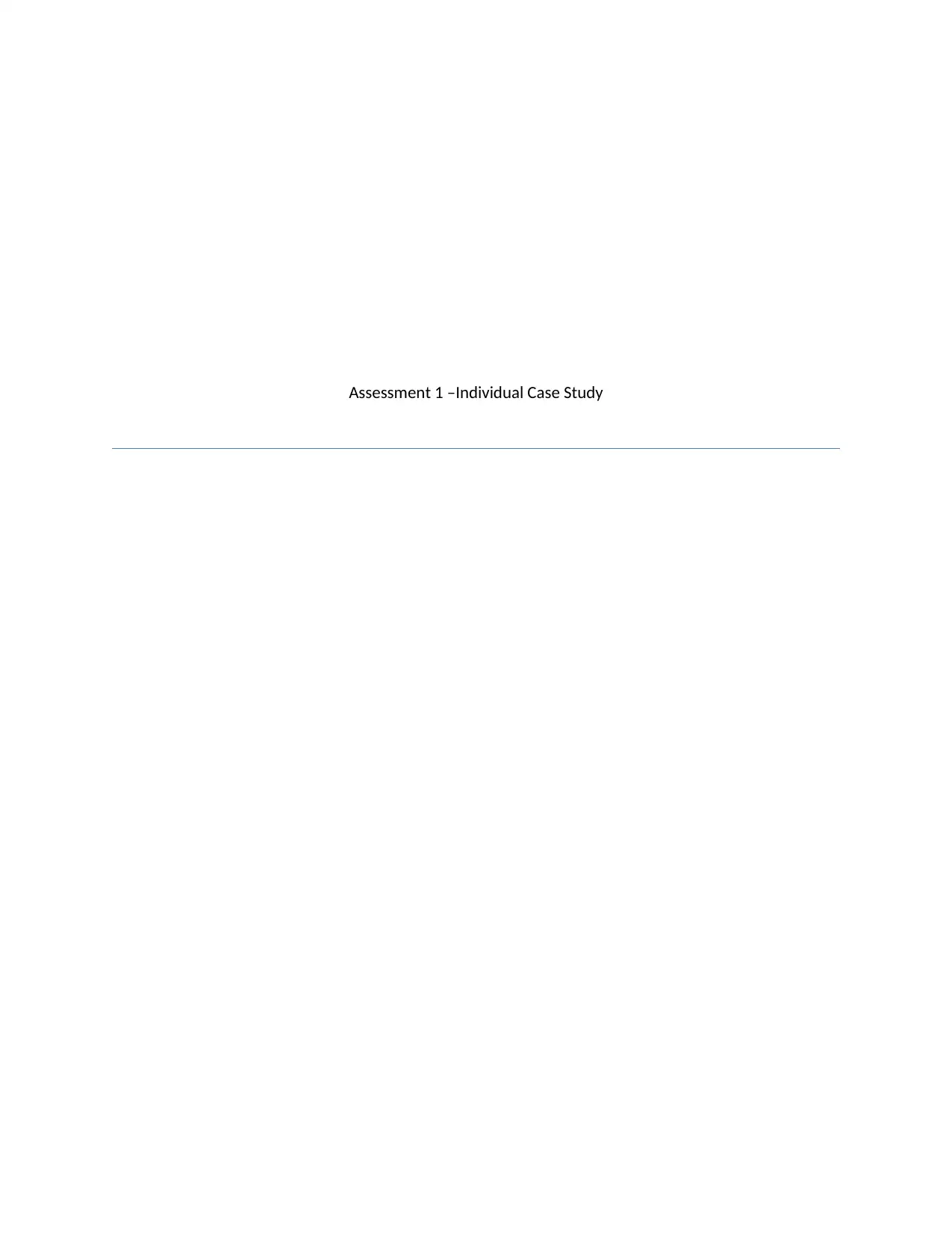
Assessment 1 –Individual Case Study
Paraphrase This Document
Need a fresh take? Get an instant paraphrase of this document with our AI Paraphraser
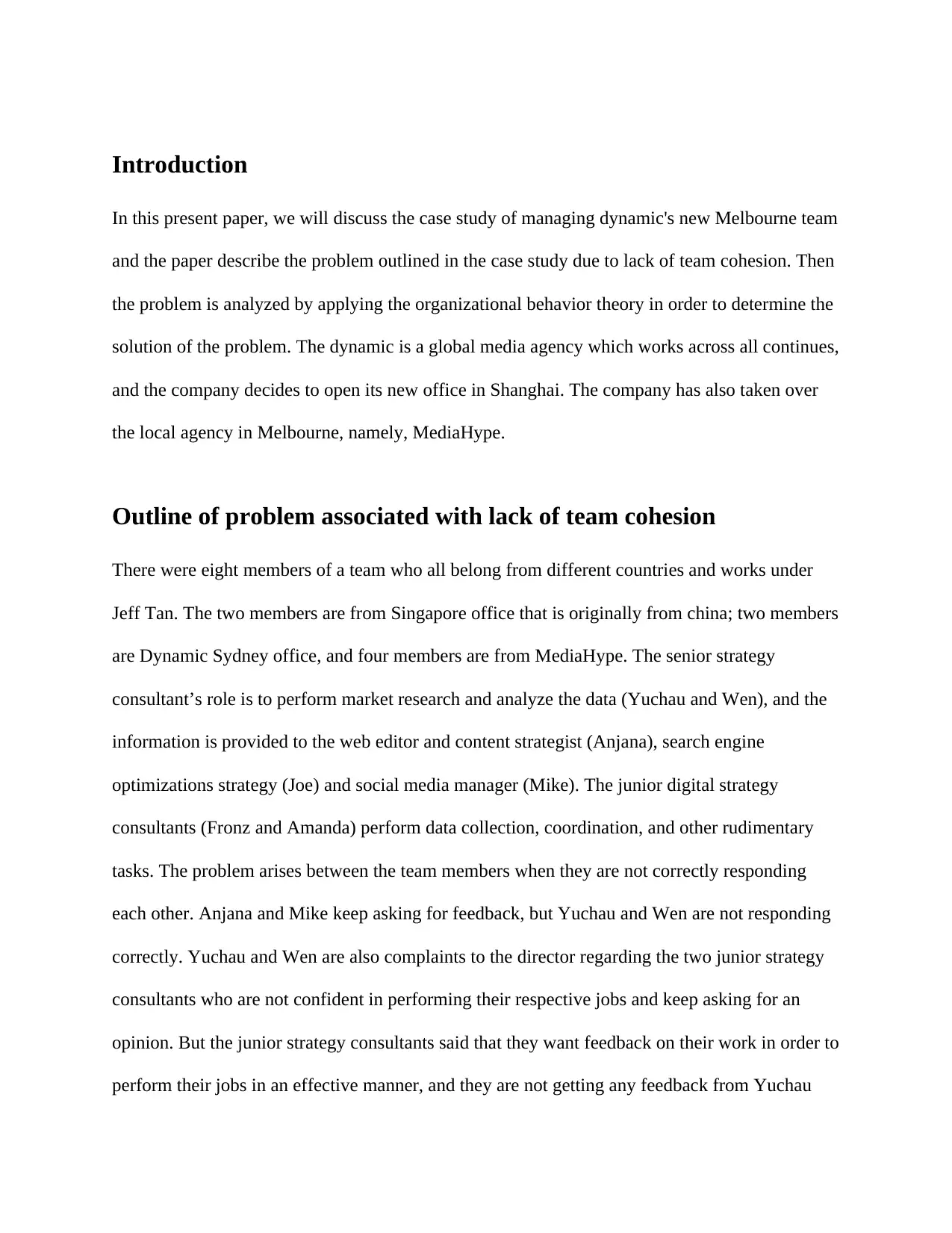
Introduction
In this present paper, we will discuss the case study of managing dynamic's new Melbourne team
and the paper describe the problem outlined in the case study due to lack of team cohesion. Then
the problem is analyzed by applying the organizational behavior theory in order to determine the
solution of the problem. The dynamic is a global media agency which works across all continues,
and the company decides to open its new office in Shanghai. The company has also taken over
the local agency in Melbourne, namely, MediaHype.
Outline of problem associated with lack of team cohesion
There were eight members of a team who all belong from different countries and works under
Jeff Tan. The two members are from Singapore office that is originally from china; two members
are Dynamic Sydney office, and four members are from MediaHype. The senior strategy
consultant’s role is to perform market research and analyze the data (Yuchau and Wen), and the
information is provided to the web editor and content strategist (Anjana), search engine
optimizations strategy (Joe) and social media manager (Mike). The junior digital strategy
consultants (Fronz and Amanda) perform data collection, coordination, and other rudimentary
tasks. The problem arises between the team members when they are not correctly responding
each other. Anjana and Mike keep asking for feedback, but Yuchau and Wen are not responding
correctly. Yuchau and Wen are also complaints to the director regarding the two junior strategy
consultants who are not confident in performing their respective jobs and keep asking for an
opinion. But the junior strategy consultants said that they want feedback on their work in order to
perform their jobs in an effective manner, and they are not getting any feedback from Yuchau
In this present paper, we will discuss the case study of managing dynamic's new Melbourne team
and the paper describe the problem outlined in the case study due to lack of team cohesion. Then
the problem is analyzed by applying the organizational behavior theory in order to determine the
solution of the problem. The dynamic is a global media agency which works across all continues,
and the company decides to open its new office in Shanghai. The company has also taken over
the local agency in Melbourne, namely, MediaHype.
Outline of problem associated with lack of team cohesion
There were eight members of a team who all belong from different countries and works under
Jeff Tan. The two members are from Singapore office that is originally from china; two members
are Dynamic Sydney office, and four members are from MediaHype. The senior strategy
consultant’s role is to perform market research and analyze the data (Yuchau and Wen), and the
information is provided to the web editor and content strategist (Anjana), search engine
optimizations strategy (Joe) and social media manager (Mike). The junior digital strategy
consultants (Fronz and Amanda) perform data collection, coordination, and other rudimentary
tasks. The problem arises between the team members when they are not correctly responding
each other. Anjana and Mike keep asking for feedback, but Yuchau and Wen are not responding
correctly. Yuchau and Wen are also complaints to the director regarding the two junior strategy
consultants who are not confident in performing their respective jobs and keep asking for an
opinion. But the junior strategy consultants said that they want feedback on their work in order to
perform their jobs in an effective manner, and they are not getting any feedback from Yuchau
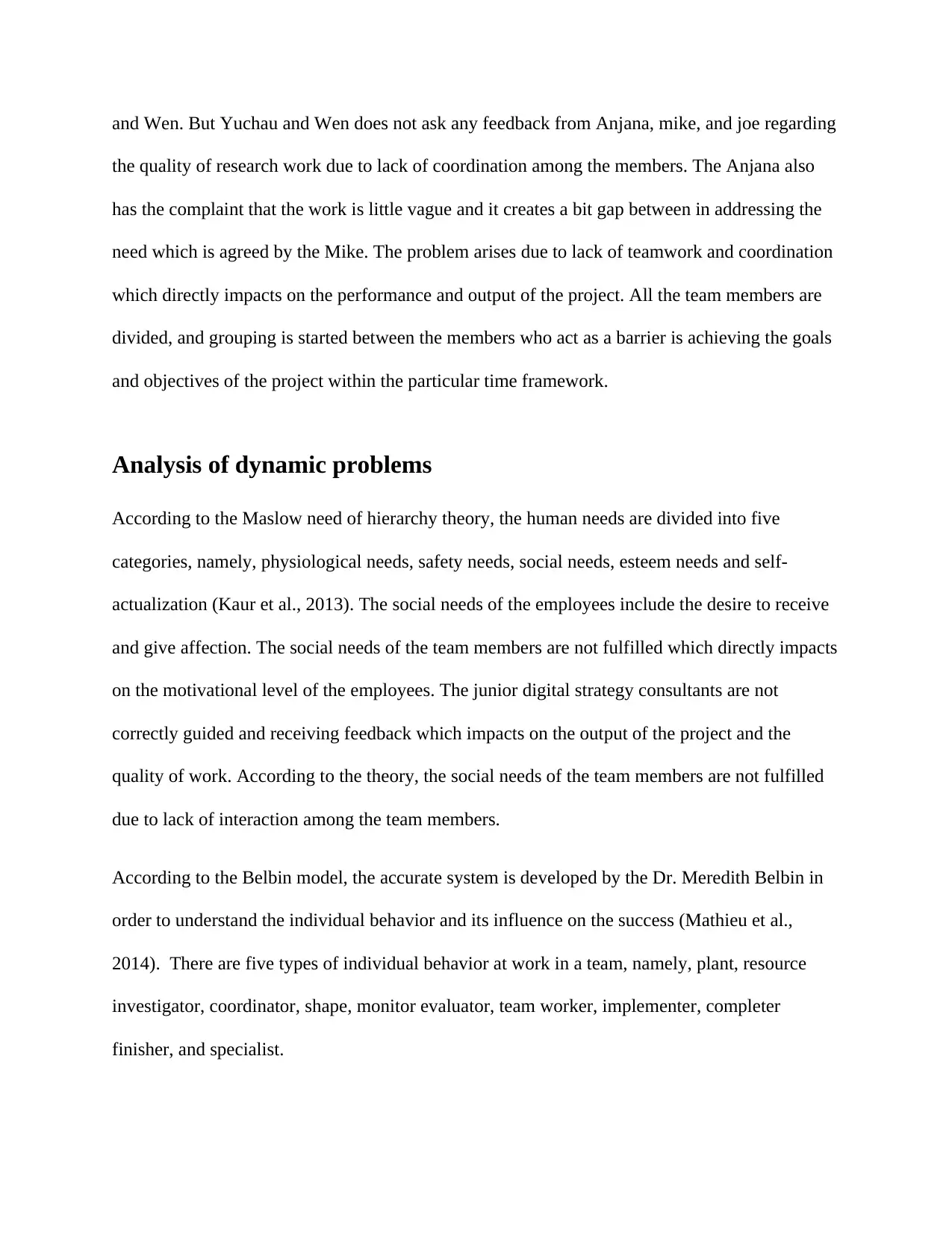
and Wen. But Yuchau and Wen does not ask any feedback from Anjana, mike, and joe regarding
the quality of research work due to lack of coordination among the members. The Anjana also
has the complaint that the work is little vague and it creates a bit gap between in addressing the
need which is agreed by the Mike. The problem arises due to lack of teamwork and coordination
which directly impacts on the performance and output of the project. All the team members are
divided, and grouping is started between the members who act as a barrier is achieving the goals
and objectives of the project within the particular time framework.
Analysis of dynamic problems
According to the Maslow need of hierarchy theory, the human needs are divided into five
categories, namely, physiological needs, safety needs, social needs, esteem needs and self-
actualization (Kaur et al., 2013). The social needs of the employees include the desire to receive
and give affection. The social needs of the team members are not fulfilled which directly impacts
on the motivational level of the employees. The junior digital strategy consultants are not
correctly guided and receiving feedback which impacts on the output of the project and the
quality of work. According to the theory, the social needs of the team members are not fulfilled
due to lack of interaction among the team members.
According to the Belbin model, the accurate system is developed by the Dr. Meredith Belbin in
order to understand the individual behavior and its influence on the success (Mathieu et al.,
2014). There are five types of individual behavior at work in a team, namely, plant, resource
investigator, coordinator, shape, monitor evaluator, team worker, implementer, completer
finisher, and specialist.
the quality of research work due to lack of coordination among the members. The Anjana also
has the complaint that the work is little vague and it creates a bit gap between in addressing the
need which is agreed by the Mike. The problem arises due to lack of teamwork and coordination
which directly impacts on the performance and output of the project. All the team members are
divided, and grouping is started between the members who act as a barrier is achieving the goals
and objectives of the project within the particular time framework.
Analysis of dynamic problems
According to the Maslow need of hierarchy theory, the human needs are divided into five
categories, namely, physiological needs, safety needs, social needs, esteem needs and self-
actualization (Kaur et al., 2013). The social needs of the employees include the desire to receive
and give affection. The social needs of the team members are not fulfilled which directly impacts
on the motivational level of the employees. The junior digital strategy consultants are not
correctly guided and receiving feedback which impacts on the output of the project and the
quality of work. According to the theory, the social needs of the team members are not fulfilled
due to lack of interaction among the team members.
According to the Belbin model, the accurate system is developed by the Dr. Meredith Belbin in
order to understand the individual behavior and its influence on the success (Mathieu et al.,
2014). There are five types of individual behavior at work in a team, namely, plant, resource
investigator, coordinator, shape, monitor evaluator, team worker, implementer, completer
finisher, and specialist.
⊘ This is a preview!⊘
Do you want full access?
Subscribe today to unlock all pages.

Trusted by 1+ million students worldwide
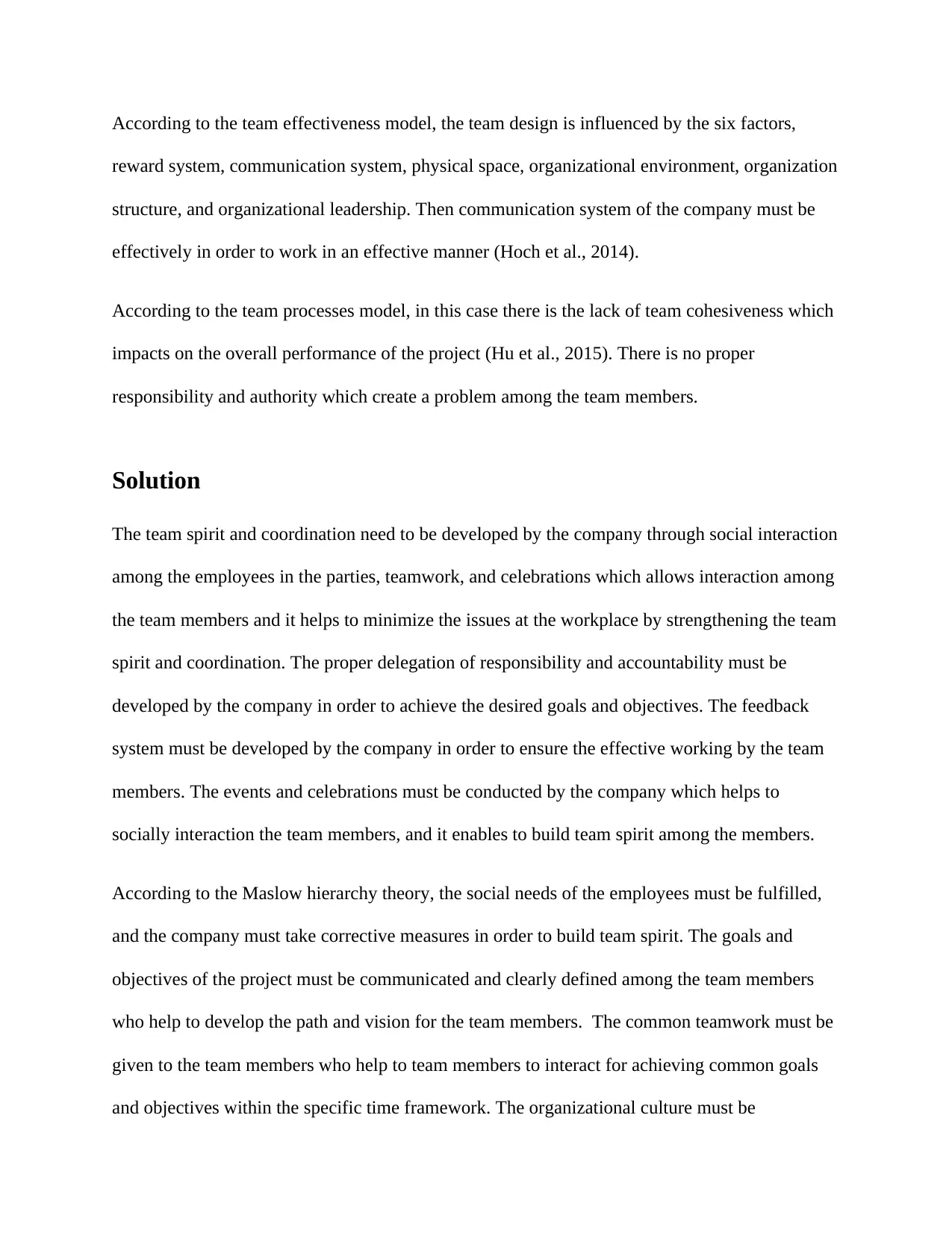
According to the team effectiveness model, the team design is influenced by the six factors,
reward system, communication system, physical space, organizational environment, organization
structure, and organizational leadership. Then communication system of the company must be
effectively in order to work in an effective manner (Hoch et al., 2014).
According to the team processes model, in this case there is the lack of team cohesiveness which
impacts on the overall performance of the project (Hu et al., 2015). There is no proper
responsibility and authority which create a problem among the team members.
Solution
The team spirit and coordination need to be developed by the company through social interaction
among the employees in the parties, teamwork, and celebrations which allows interaction among
the team members and it helps to minimize the issues at the workplace by strengthening the team
spirit and coordination. The proper delegation of responsibility and accountability must be
developed by the company in order to achieve the desired goals and objectives. The feedback
system must be developed by the company in order to ensure the effective working by the team
members. The events and celebrations must be conducted by the company which helps to
socially interaction the team members, and it enables to build team spirit among the members.
According to the Maslow hierarchy theory, the social needs of the employees must be fulfilled,
and the company must take corrective measures in order to build team spirit. The goals and
objectives of the project must be communicated and clearly defined among the team members
who help to develop the path and vision for the team members. The common teamwork must be
given to the team members who help to team members to interact for achieving common goals
and objectives within the specific time framework. The organizational culture must be
reward system, communication system, physical space, organizational environment, organization
structure, and organizational leadership. Then communication system of the company must be
effectively in order to work in an effective manner (Hoch et al., 2014).
According to the team processes model, in this case there is the lack of team cohesiveness which
impacts on the overall performance of the project (Hu et al., 2015). There is no proper
responsibility and authority which create a problem among the team members.
Solution
The team spirit and coordination need to be developed by the company through social interaction
among the employees in the parties, teamwork, and celebrations which allows interaction among
the team members and it helps to minimize the issues at the workplace by strengthening the team
spirit and coordination. The proper delegation of responsibility and accountability must be
developed by the company in order to achieve the desired goals and objectives. The feedback
system must be developed by the company in order to ensure the effective working by the team
members. The events and celebrations must be conducted by the company which helps to
socially interaction the team members, and it enables to build team spirit among the members.
According to the Maslow hierarchy theory, the social needs of the employees must be fulfilled,
and the company must take corrective measures in order to build team spirit. The goals and
objectives of the project must be communicated and clearly defined among the team members
who help to develop the path and vision for the team members. The common teamwork must be
given to the team members who help to team members to interact for achieving common goals
and objectives within the specific time framework. The organizational culture must be
Paraphrase This Document
Need a fresh take? Get an instant paraphrase of this document with our AI Paraphraser
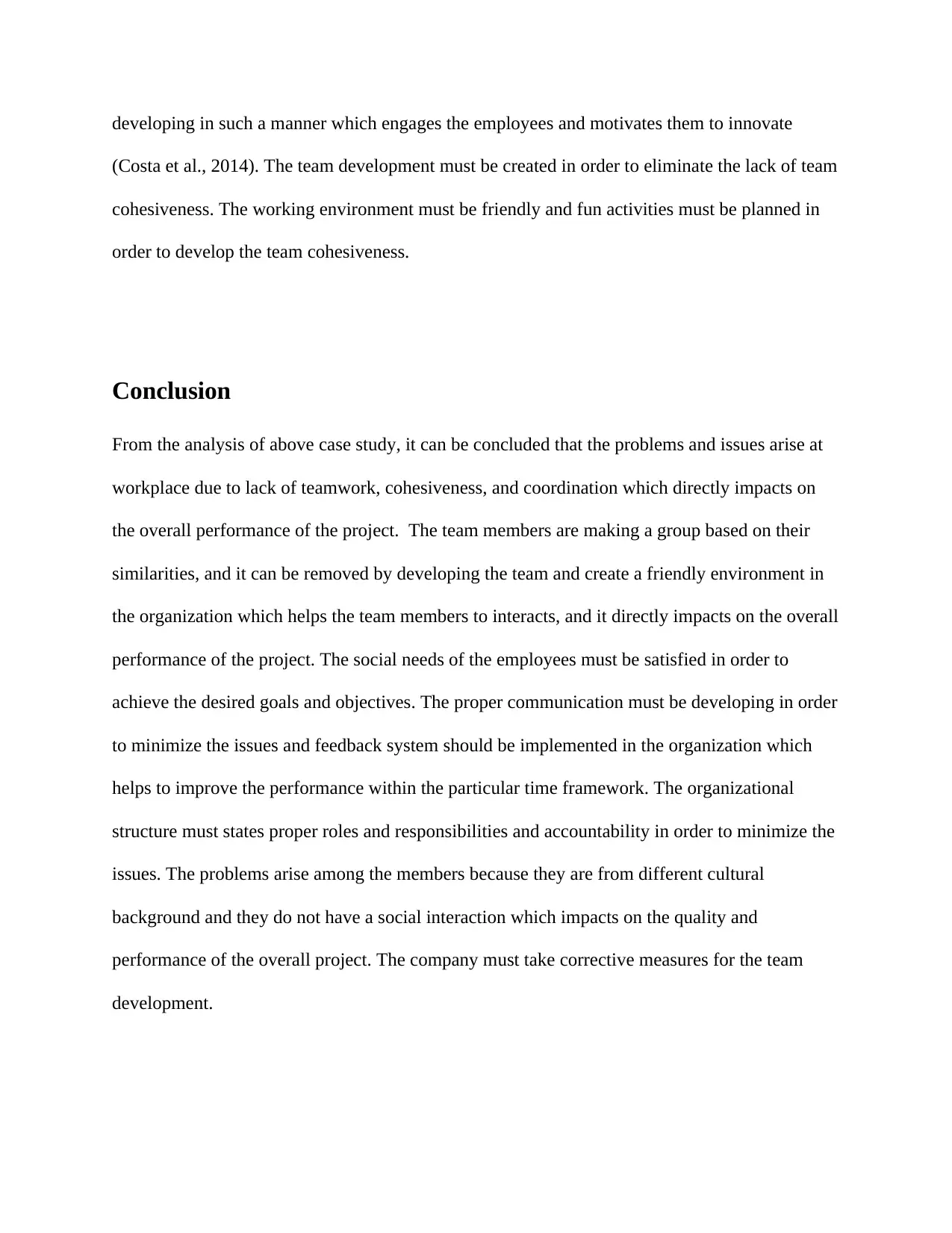
developing in such a manner which engages the employees and motivates them to innovate
(Costa et al., 2014). The team development must be created in order to eliminate the lack of team
cohesiveness. The working environment must be friendly and fun activities must be planned in
order to develop the team cohesiveness.
Conclusion
From the analysis of above case study, it can be concluded that the problems and issues arise at
workplace due to lack of teamwork, cohesiveness, and coordination which directly impacts on
the overall performance of the project. The team members are making a group based on their
similarities, and it can be removed by developing the team and create a friendly environment in
the organization which helps the team members to interacts, and it directly impacts on the overall
performance of the project. The social needs of the employees must be satisfied in order to
achieve the desired goals and objectives. The proper communication must be developing in order
to minimize the issues and feedback system should be implemented in the organization which
helps to improve the performance within the particular time framework. The organizational
structure must states proper roles and responsibilities and accountability in order to minimize the
issues. The problems arise among the members because they are from different cultural
background and they do not have a social interaction which impacts on the quality and
performance of the overall project. The company must take corrective measures for the team
development.
(Costa et al., 2014). The team development must be created in order to eliminate the lack of team
cohesiveness. The working environment must be friendly and fun activities must be planned in
order to develop the team cohesiveness.
Conclusion
From the analysis of above case study, it can be concluded that the problems and issues arise at
workplace due to lack of teamwork, cohesiveness, and coordination which directly impacts on
the overall performance of the project. The team members are making a group based on their
similarities, and it can be removed by developing the team and create a friendly environment in
the organization which helps the team members to interacts, and it directly impacts on the overall
performance of the project. The social needs of the employees must be satisfied in order to
achieve the desired goals and objectives. The proper communication must be developing in order
to minimize the issues and feedback system should be implemented in the organization which
helps to improve the performance within the particular time framework. The organizational
structure must states proper roles and responsibilities and accountability in order to minimize the
issues. The problems arise among the members because they are from different cultural
background and they do not have a social interaction which impacts on the quality and
performance of the overall project. The company must take corrective measures for the team
development.
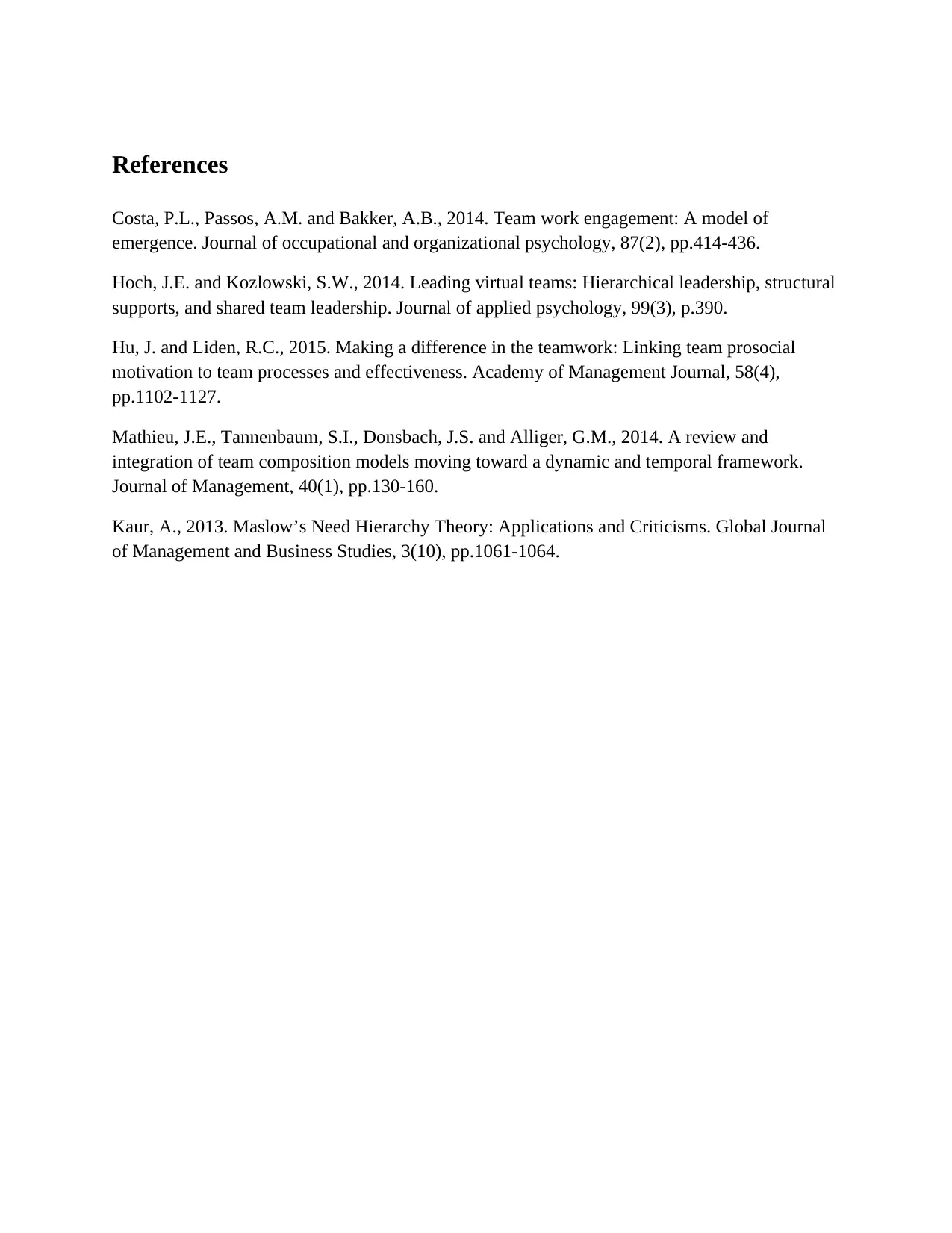
References
Costa, P.L., Passos, A.M. and Bakker, A.B., 2014. Team work engagement: A model of
emergence. Journal of occupational and organizational psychology, 87(2), pp.414-436.
Hoch, J.E. and Kozlowski, S.W., 2014. Leading virtual teams: Hierarchical leadership, structural
supports, and shared team leadership. Journal of applied psychology, 99(3), p.390.
Hu, J. and Liden, R.C., 2015. Making a difference in the teamwork: Linking team prosocial
motivation to team processes and effectiveness. Academy of Management Journal, 58(4),
pp.1102-1127.
Mathieu, J.E., Tannenbaum, S.I., Donsbach, J.S. and Alliger, G.M., 2014. A review and
integration of team composition models moving toward a dynamic and temporal framework.
Journal of Management, 40(1), pp.130-160.
Kaur, A., 2013. Maslow’s Need Hierarchy Theory: Applications and Criticisms. Global Journal
of Management and Business Studies, 3(10), pp.1061-1064.
Costa, P.L., Passos, A.M. and Bakker, A.B., 2014. Team work engagement: A model of
emergence. Journal of occupational and organizational psychology, 87(2), pp.414-436.
Hoch, J.E. and Kozlowski, S.W., 2014. Leading virtual teams: Hierarchical leadership, structural
supports, and shared team leadership. Journal of applied psychology, 99(3), p.390.
Hu, J. and Liden, R.C., 2015. Making a difference in the teamwork: Linking team prosocial
motivation to team processes and effectiveness. Academy of Management Journal, 58(4),
pp.1102-1127.
Mathieu, J.E., Tannenbaum, S.I., Donsbach, J.S. and Alliger, G.M., 2014. A review and
integration of team composition models moving toward a dynamic and temporal framework.
Journal of Management, 40(1), pp.130-160.
Kaur, A., 2013. Maslow’s Need Hierarchy Theory: Applications and Criticisms. Global Journal
of Management and Business Studies, 3(10), pp.1061-1064.
⊘ This is a preview!⊘
Do you want full access?
Subscribe today to unlock all pages.

Trusted by 1+ million students worldwide
1 out of 6
Related Documents
Your All-in-One AI-Powered Toolkit for Academic Success.
+13062052269
info@desklib.com
Available 24*7 on WhatsApp / Email
![[object Object]](/_next/static/media/star-bottom.7253800d.svg)
Unlock your academic potential
Copyright © 2020–2025 A2Z Services. All Rights Reserved. Developed and managed by ZUCOL.



